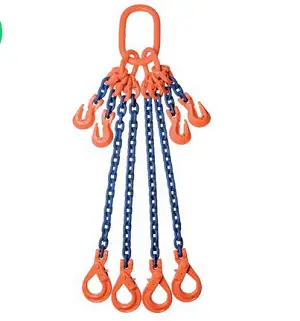Each Leg Counts: A Deep Dive into 4-Leg Chain Sling Applications

Introduction
In the realm of heavy lifting and material handling, the choice of lifting equipment is a critical factor that directly impacts the safety, efficiency, and success of operations. Among the diverse range of lifting solutions, 4 leg chain sling stand out as versatile and robust tools designed to handle complex lifting scenarios. In this comprehensive exploration, we will delve into the features, applications, benefits, and considerations associated with 4-leg chain slings, shedding light on their significance in enhancing lifting operations.
Understanding 4-Leg Chain Slings
4-leg chain slings are specialized lifting devices consisting of four individual legs connected to a master link or fitting at the top. These slings are designed to distribute the load weight evenly across the legs, providing stability and support for lifting heavy and often irregularly shaped loads. The legs are typically connected to a master link at the top, which is then attached to the lifting equipment.
Key Features of 4-Leg Chain Slings
-
Symmetrical Design: The symmetrical design of 4-leg chain slings allows for an even distribution of the load weight, providing stability and preventing imbalances during lifting operations. This design is particularly advantageous when lifting large or irregularly shaped loads.
-
Multiple Attachment Points: With four legs, these slings offer multiple attachment points for securing the load. This versatility allows for various configurations, adapting to different load shapes and sizes.
-
Adjustable Leg Lengths: Many 4-leg chain slings come with adjustable leg lengths, providing flexibility in accommodating different load dimensions. This feature is crucial for ensuring a secure and balanced lift.
Applications of 4-Leg Chain Slings
The versatility of 4-leg chain slings makes them suitable for a wide range of lifting applications across various industries:
-
Steel Manufacturing: In steel mills and manufacturing facilities, 4-leg chain slings are commonly used for lifting and transporting steel coils, beams, and other heavy metal components.
-
Construction: These slings find applications in construction projects for lifting and positioning large precast concrete elements, steel structures, or heavy machinery.
-
Shipbuilding: The symmetrical load distribution provided by 4-leg chain slings is advantageous in shipyards for lifting and assembling ship components, ensuring a balanced and controlled lift.
-
Oil and Gas Industry: In the oil and gas sector, 4-leg chain slings are utilized for lifting and transporting heavy equipment, pipes, and other components in both onshore and offshore operations.
Benefits of 4-Leg Chain Slings
-
Balanced Load Distribution: The symmetrical design of 4-leg chain slings ensures an even distribution of the load weight across all legs. This balanced load distribution enhances stability during lifting operations, reducing the risk of load shifts or imbalances.
-
Versatility in Load Handling: The multiple attachment points and adjustable leg lengths of 4-leg chain slings provide versatility in handling various load shapes and sizes. This adaptability is crucial in lifting scenarios where the load characteristics may vary.
-
Efficient Handling of Irregular Loads: The stability offered by 4-leg chain slings makes them particularly effective for lifting irregularly shaped loads, providing support and control during the lift.
-
Reduced Stress on Each Leg: The load weight is distributed evenly among the four legs, reducing the stress on individual legs and promoting longevity and durability of the chain sling.
Considerations for Optimal Performance
While the benefits of 4-leg chain slings are significant, certain considerations are essential for ensuring optimal performance and safety:
-
Proper Sizing: Selecting the appropriate size of the 4-leg chain sling for the intended load is critical. An improperly sized sling may compromise safety and lifting efficiency.
-
Inspection and Maintenance: Regular inspection of the chain sling for signs of wear, corrosion, or damage is crucial. Damaged components should be promptly replaced to maintain safety standards.
-
Load Centering: Ensuring that the load is properly centered and balanced within the sling is essential for achieving an even distribution of the load weight across all four legs.
Conclusion
In conclusion, 4-leg chain slings play a crucial role in lifting operations where stability, balance, and versatility are paramount. Their symmetrical design, multiple attachment points, and adjustable leg lengths make them ideal for handling heavy and irregularly shaped loads across various industries. The balanced load distribution provided by 4-leg chain slings contributes to safer and more controlled lifting operations, reducing the risk of accidents and enhancing overall workplace safety.
By understanding the key features, applications, and considerations associated with 4-leg chain slings, professionals can make informed decisions, optimizing the use of these versatile lifting tools. Each leg in a 4-leg chain sling indeed counts, contributing to the success of lifting operations by providing stability, control, and efficiency. As an integral component in the toolkit of material handling professionals, 4-leg chain slings ensure that complex lifting tasks are executed with precision, safety, and reliability.
